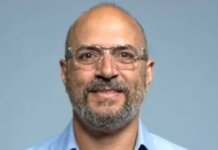 BLOG VIEW: For the past eight years, I've pursued a second career as an actor in horror movies. These productions are low-budget efforts that go straight to DVD – and while I don't see the likelihood of an Academy Award in the foreseeable future, I have great pride in being the recipient of the 2008 B-Movie Film Festival's Best Supporting Actor Award for my performance as Professor Shipwreck in ‘Bikini Bloodbath Car Wash.’Â
BLOG VIEW: For the past eight years, I've pursued a second career as an actor in horror movies. These productions are low-budget efforts that go straight to DVD – and while I don't see the likelihood of an Academy Award in the foreseeable future, I have great pride in being the recipient of the 2008 B-Movie Film Festival's Best Supporting Actor Award for my performance as Professor Shipwreck in ‘Bikini Bloodbath Car Wash.’Â
I maintain a large number of professional connections in both the horror-movie orbit and the mortgage banking industry, and this unlikely overlap has illicited some very strange reactions. Many people within mortgage banking react with delight that I am following in Vincent Price's footsteps, while my colleagues in the film world are mostly confused and surprised that I would be associated with something as terrifying as (gasp!) mortgage banking.
But upon reflection, I have realized that mortgage banking is not very different from horror movies. In fact, the basic tenets that govern the screamfest circuit also turn up in the financial services world. Let's consider a few areas where these two seemingly unrelated worlds spin in perfect alignment.
Reckless behavior creates untold havoc. Many horror films are predicated on people doing very dumb things – upsetting a cursed tomb, irritating a sleeping monster, venturing into haunted houses, stealing rare treasures guarded by demons, etc. The same thing applies to mortgage banking. In this case, reckless behavior played a huge role in the creation of the housing bubble – most egregiously, in the lack of due diligence and the emphasis on loan quantity over loan quality. It continues to play a role in delaying the industry's recovery – especially in this summer's unwelcome news that the major servicers were still using robo-signing, despite promises to the contrary.
Solving catastrophic problems creates even greater pain. In horror movies, there is no easy solution to the monstrous tumult – someone or many people wind up getting hurt very badly in the effort to put things back the way they were. In my horror films, I'm usually on the receiving end of such chaos – most recently, in ‘Rudyard Kipling's Mark of the Beast,’ I play a demon-possessed character that undergoes a gruesome exorcism that involves many indignities, including kicks in the head and being showered with cold, wet worms. (I also did my own stunts – trust me, anyone who says show business is glamorous has never worked in show business!)
The same principle of a rough cure to a harsh injury applies in mortgage banking – minus the cold shower of worms, of course. Many companies have gone out of business, and thousands of jobs have been jettisoned since the Lehman Brothers crash in September 2008. The deepest cut to date occurred last week, when Bank of America announced it was laying off 30,000 employees – a big leap from its Aug. 19 projection of 3,500 positions being axed. I expect more deep personnel cuts will be announced in the coming months – particularly before the year-end holidays.
And that's just on the human resources side. Don't forget the legal aspects of the industry – it has become impossible to pass a weekday without news that some major financial services provider is being sued for problems relating to its mortgage-backed securities. I think we can all agree that few things are more painful than litigation.
Villains often emerge unscathed. Horror films are special because many of the bad guys of the genre never receive their full comeuppance. In many cases, they keep returning for endless sequels and franchise reboots.
The same often happens in mortgage banking. In the aftermath of the recession, there's been very little in the way of judicial pursuit of those responsible for the collapse of the industry. A few players have been brought to trial and prison – most notably from the C-suite of Taylor, Bean & Whitaker. But many people who played a significant role in the debacle – particularly the notorious Angelo Mozilo of Countrywide Financial – dropped a couple of million dollars on federal and state fines and escaped the perp walk.
Even worse, the politicians who contributed to the crisis have yet to be held accountable for their actions. This is particularly galling in regard to the collapse of the government-sponsored enterprises (GSEs). Back in April, political activist Ralph Nader demanded that the Treasury Department investigate July 2008 statements from GSE executives and federal officials, including Federal Reserve Chairman Ben Bernanke and Rep. Barney Frank, that gave the impression that Fannie Mae and Freddie Mac were financially sound. To date, the Treasury Department has ignored Nader's inquiry.
Ultimately, a horror movie is only a movie – you pay to get scared, and hopefully, you enjoy a good laugh about it afterwards. Sometimes, though, reality and make-believe get blurred: Earlier this year, Sen. Chris Dodd, the former chairman of the Senate Banking Committee and co-author of the disastrous Dodd-Frank Act, left Washington and headed to Hollywood to become the head of the Motion Picture Association of America. To take a line from Joseph Conrad, ‘The horror! The horror!’
– Phil Hall, editor, Secondary Marketing Executive
(Please address all comments regarding this opinion column to hallp@sme-online.com.)













